Understanding Wetting Agents
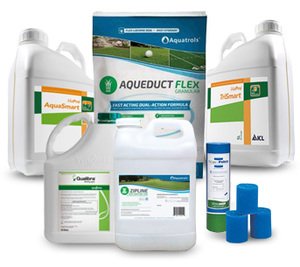
Skilful management of water is a fundamental aspect of producing high quality and consistent turf surfaces. Water is a master variable which directly impacts the function of grass plants and soil organisms. It is also a master solvent responsible for a whole host of essential chemical reactions underpinning the soil ecosystem.
Wetting agents are types of chemical compounds classified as surfactants, they are defined as substances which reduce the surface tension of water allowing it to spread onto a surface as a film.
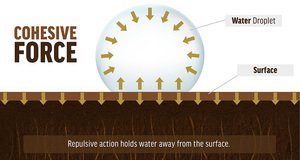
Intermolecular forces (IMF) are the forces which govern the interaction between different molecules at the macroscale (water droplets) rather the microscale (water mist) or atomic scale (water molecule), broadly they are defined as attractive or repulsive.
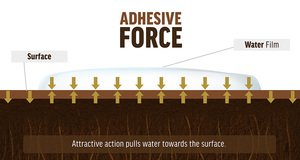 Cohesive forces are forces exerted between molecules; water has a strong cohesive force tightly pulling its molecules together into a sphere, which is why rain falls as droplets rather than mist.
Cohesive forces are forces exerted between molecules; water has a strong cohesive force tightly pulling its molecules together into a sphere, which is why rain falls as droplets rather than mist.
Adhesive forces are attractive forces between unrelated molecules. When the adhesive forces between water and another molecule (e.g. a chemcal compound constituting a soil particle mineral) are strong enough, they overcome the cohesive force of the water molecules, pulling them out of their spherical shape. When the water is pulled out of its spherical shape it spreads across and clings to the surface it is adhered to.
In the context of turf management cohesive and adhesive forces govern how water penetrates the ground and interacts with the surface of soil particles.
Optimal Conditions – Hydrophilic
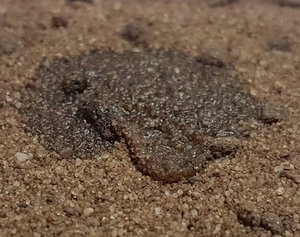 In optimal conditions soils have high adhesive forces able to overcome the cohesive force of a water droplet. When this happens the surface tension of the water droplet is broken, it then spreads out over the surface of the soil particle coating it in a liquid film. This liquid film acts as storage reservoir within the soil, which plants are then able to access via their roots. Soils which act in this way are said to be hydrophilic. The definition of “hydrophilic” can easily be gleaned from its Greek roots; hydro (meaning water) and philic (meaning love or affinity for).
In optimal conditions soils have high adhesive forces able to overcome the cohesive force of a water droplet. When this happens the surface tension of the water droplet is broken, it then spreads out over the surface of the soil particle coating it in a liquid film. This liquid film acts as storage reservoir within the soil, which plants are then able to access via their roots. Soils which act in this way are said to be hydrophilic. The definition of “hydrophilic” can easily be gleaned from its Greek roots; hydro (meaning water) and philic (meaning love or affinity for).
Non-Optimal Soil Conditions – Hydrophobic
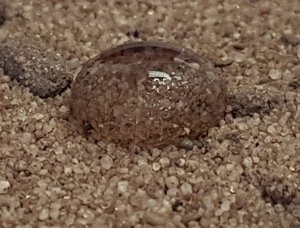 Over time certain conditions can lead to waxy organic material building up and coating soil particles with strong cohesive forces. In turn these forces encourage water to bead and repel away from the surface of a soil particle. When these conditions are present the soil is said to by hydrophobic, or water repellent. Again, the Greek roots of this word reveal its meaning; hydro (meaning water) and phobic (meaning fear or hate). It is this water repellency which causes drought stress and localised dry patch because water, either from rain or irrigation, is unable to adhere and spread across soil particles where roots can access it. Instead it either fails to penetrate the surface; consequently running away as wash off, evaporates into the atmosphere or; it simply passes straight through the profile into drainage systems or subsoil. In all of these cirsumstances water is not available to the plants roots for absorbtion and healthy metabolic function (life).
Over time certain conditions can lead to waxy organic material building up and coating soil particles with strong cohesive forces. In turn these forces encourage water to bead and repel away from the surface of a soil particle. When these conditions are present the soil is said to by hydrophobic, or water repellent. Again, the Greek roots of this word reveal its meaning; hydro (meaning water) and phobic (meaning fear or hate). It is this water repellency which causes drought stress and localised dry patch because water, either from rain or irrigation, is unable to adhere and spread across soil particles where roots can access it. Instead it either fails to penetrate the surface; consequently running away as wash off, evaporates into the atmosphere or; it simply passes straight through the profile into drainage systems or subsoil. In all of these cirsumstances water is not available to the plants roots for absorbtion and healthy metabolic function (life).
Understanding Types of Wetting Agent Surfactants
 Soil Surfactants (wetting agents) can bridge the gap between philic and phobic soils but; it is important to understand that all wetting agents are not the same. With the increase of new technologies and formulations; understanding the fundamental mechanisms which govern how water behaves in and interacts with a soil, aids understanding of the action and intended effect of different classifications of wetting agent surfactants.
Soil Surfactants (wetting agents) can bridge the gap between philic and phobic soils but; it is important to understand that all wetting agents are not the same. With the increase of new technologies and formulations; understanding the fundamental mechanisms which govern how water behaves in and interacts with a soil, aids understanding of the action and intended effect of different classifications of wetting agent surfactants.
Wetting agents can be formulated with a blend of differing chemistries, each one taken from the subsequent classifications listed below.
Blended products are formulated to offer multiple effects in the soil profile. For example mixing a curative with a penetrant acts to both strip away the organic waxy hydrophobic coating from soil particles (curative portion) whilst simultaneously breaking water tension to encourage penetration through the profile (penetrant portion). By understanding the way classifications of wetting agent chemistry work turf mangers can make better informed decisions on what combination of blended surfactant chemistries they should seek to utilise.
Water Retention – Block Copolymer
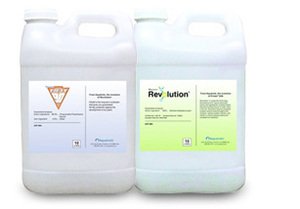 There are a number of block copolymer wetting agent chemistries available. They each vary in their molecular arrangement, weight and chain length.
There are a number of block copolymer wetting agent chemistries available. They each vary in their molecular arrangement, weight and chain length.
Use block copolymers wetting agents as a preventative strategy against the onset of localised dry patch during the summer. Apply block copolymer wetting agents from March onwards. To attain peak performance they must be allowed to build up in the soil profile. The way each molecule is constructed determines their longevity and effect in the soil. Broadly speaking block copolymers retain and spread water throughout the soil profile with the aim of maintaining uniform soil moisture.
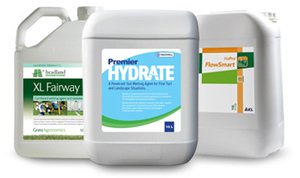
Designed to break the surface tension of water enabling it to flow down into soils more effectively.
Use when seeking to aid penetration of rain and irrigation water throughout the soil profile. Either to wet a soil or when aiming to release moisture trapped in surface organic material.
Capable of removing the organic substances coating soil particles which cause hydrophobic behaviour.
Use in soils where localised dry patch is evident. Some curative wetting agents can be antagonistic to soil microorganisms so should be used sparingly.
Increasingly the pressure of climate change mean that management of the core master variable within the soil is more and more relevant. As extremes in the climate push conditions from a period of prolonged drought pressure and therefore water stress, to periods of heavy rainfall and waterlogging the next. Understanding the fundamentals of how surfactant wetting agents operate and then thinking about how to deal with the extremes of weather, via a simple annual wetting agent management plan, is a sensible and straightforward means to cover all manner of eventualities the climate may conjure up throughout the year.

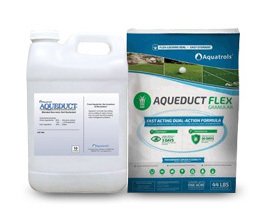 Curative
Curative